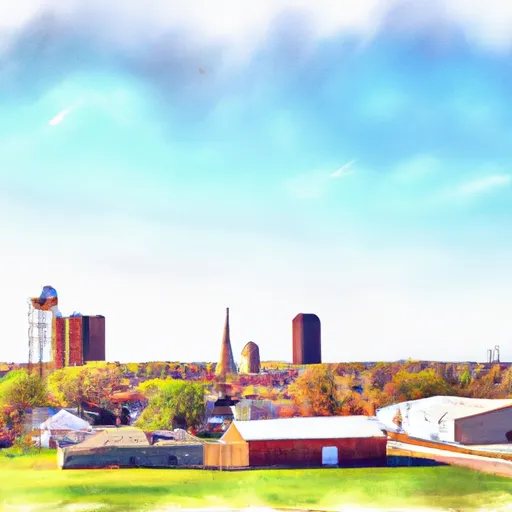-
 Snoflo Premium
Snoflo Premium
Get unlimited access to all our content
With no Ad interruptions! - Start Your Free Trial Login with existing account
Ridge-Farm
Eden Index
Climate
8.1
•
Recreation
2.8
•
Community
•
Safeguard
4.2/10

Ridge Farm is a small village located in Vermilion County, Illinois, United States. It has a humid continental climate, characterized by warm summers and cold winters. The average high temperature in summer is around 85°F (29°C), while winter temperatures can drop to an average low of 19°F (-7°C). Precipitation is fairly evenly distributed throughout the year, with an average annual rainfall of 40 inches (102 cm) and snowfall of around 20 inches (51 cm).
The hydrology constituents of Ridge Farm are primarily influenced by the Middle Fork Vermilion River, which flows through the village. The river provides opportunities for fishing and boating, with common fish species including bass, catfish, and bluegill. Additionally, the river serves as a scenic spot for nature walks, birdwatching, and photography.
Outdoor recreation enthusiasts can also explore the nearby Kickapoo State Recreation Area, located just a few miles northwest of Ridge Farm. This state park offers various activities such as camping, hiking, horseback riding, mountain biking, and hunting. The park is known for its diverse wildlife, beautiful trails, and scenic lakes, providing a wide range of opportunities for outdoor adventure and relaxation.
What is the Eden Index?
The Snoflo Eden Index serves as a comprehensive rating system for regions, evaluating their desirability through a holistic assessment of climate health, outdoor recreation opportunities, and natural disaster risk, acknowledging the profound impact of these factors on livability and well-being.
Climate Health Indicator (CHI): 8.1
Ridge-Farm receives approximately
1028mm of rain per year,
with humidity levels near 81%
and air temperatures averaging around
12°C.
Ridge-Farm has a plant hardyness factor of
5, meaning
plants and agriculture in this region thrive during a short period during spring and early summer. Most
plants will die off during the colder winter months.
By considering the ideal temperature range, reliable water supplies, clean air, and stable seasonal rain or snowpacks, the Climate Health Indicator (CHI) underscores the significance of a healthy climate as the foundation for quality living.
A healthy climate is paramount for ensuring a high quality of life and livability in a region, fostering both physical well-being and environmental harmony. This can be characterized by ideal temperatures, reliable access to water supplies, clean air, and consistent seasonal rain or snowpacks.
Weather Forecast
Streamflow Conditions
Wabash
Area Rivers
Wabash
Snowpack Depths
Wabash
Reservoir Storage Capacity
Wabash
Groundwater Levels
Recreational Opportunity Index (ROI): 2.8
The Recreational Opportunity Index (ROI) recognizes the value of outdoor recreational options, such as parks, hiking trails, camping sites, and fishing spots, while acknowledging that climate plays a pivotal role in ensuring the comfort and consistency of these experiences.
Access to outdoor recreational opportunities, encompassing activities such as parks, hiking, camping, and fishing, is crucial for overall well-being, and the climate plays a pivotal role in enabling and enhancing these experiences, ensuring that individuals can engage in nature-based activities comfortably and consistently.
Camping Areas
| Campground | Campsites | Reservations | Toilets | Showers | Elevation |
|---|---|---|---|---|---|
| Red Hills Lake State Park | 130 | 519 ft | |||
| Destiny Parks Military - Fort Campbell | None | 544 ft | |||
| Mill Creek Park | 140 | 657 ft | |||
| Ouabache Trails County Park | 45 | 446 ft | |||
| Robinson City Park | None | 541 ft | |||
| Lincoln Trail | None | 412 ft | |||
| Kimmell City Park | 10 | 415 ft | |||
| Lincoln Trail State Park | 240 | 655 ft | |||
| Paris City Park | None | 668 ft | |||
| Meriwether Lewis | 32 | 963 ft |
Nearby Ski Areas
Catastrophe Safeguard Index (CSI):
The Catastrophe Safeguard Index (CSI) recognizes that natural disaster risk, encompassing floods, fires, hurricanes, and tornadoes, can drastically affect safety and the overall appeal of an area.
The level of natural disaster risk in a region significantly affects safety and the overall livability, with climate change amplifying these risks by potentially increasing the frequency and intensity of events like floods, fires, hurricanes, and tornadoes, thereby posing substantial challenges to community resilience and well-being.
Community Resilience Indicator (CRI):
The Community Resilience Indicator (CRI) recognizes that education, healthcare, and socioeconomics are crucial to the well-being of a region. The CRI acknowledges the profound impact of these elements on residents' overall quality of life. By evaluating educational resources, healthcare accessibility, and economic inclusivity, the index captures the essential aspects that contribute to a thriving community, fostering resident satisfaction, equity, and social cohesion.

